Sophisticated technology for general onboard wellbeing
|
|
You are bound to
feel comfortable in your vehicle if you have plenty of space
– particularly if it is just where you want it. This means
getting into and out of your passenger compartment easily
and conveniently. Once seated, you find yourself surrounded
by an airy, user-friendly, climate-controlled, soundproofed,
well-lit environment with oceans of glass and controls that
are easy to identify, reach and manoeuvre. These features
are even more important when you spend hours and hours on
board because your vehicle is your place of work. For this
reason, the new Ducato boasts outstanding attributes in the
field of passenger room, ergonomics, climate control and
acoustic insulation. Not to mention the fact that the new
model features many other new products that illustrate its
comfort, for example, the sophisticated Blue&Me system, a
rear TV camera and Cruise Control.
Acoustic and vibrational
comfort
On-board silence is about much more than comfort. It is also
an important preventive safety requirement. It promotes
driver awareness and allows you to undertake long trips
without getting tired. When we developed the New Ducato we
therefore revised the acoustic insulation thoroughly to
reduce noise transmitted from the engine and suspension and
to limit vibration, wind-noise and aerodynamic wind noise.
The final result makes the model one of the quietest
vehicles in its category: the articulation index is 49 when
travelling at 120 km/h in fifth gear (the figure for the
previous model was 44). It rises to 50 when the vehicle
accelerates in third gear to 4000 rpm (compared to 45 for
the previous version). The total acoustic comfort value is
74 decibels at 120 km/h in fifth gear and 75 decibels in
third gear at 4000 rpm (the values for the current Ducato
are 76 and 79 respectively). In particular, polyurethane
foams (sound absorbent) and heat-expanding membranes were
used to seal the panels and box sections to ensure
insulation on the New Ducato. To damp aerial transmission,
particular attention was concentrated on sealing the cab
compartment from outside in order to reduce noise due to
rolling and wind noise. The higher distance between cab door
hinge centre lines and greater cab rigidity allowed us to
achieve lower wind noise and lower noise levels while also
improving door closure. The size of the flexible suspension
bushes (front and rear) were also increased. Together with
greater bush flexibility and higher body rigidity at the
connection points, this has brought about a reduction in
vibrations and noise transmitted by the road surface.
Another new feature that has allowed us to reduce weights
and achieve outstanding acoustic performance was the
replacement of the traditional IFF (sheet of sound-deadening
material applied by hand under the body and then
heat-treated by placing the vehicle in painting ovens) by
the automatic application of a special spray treatment by
robots. This treatment takes place in the plant paint shop
and allows greater efficiency to be achieved by applying the
material in the correct thickness, only where required.
Development of the chassis and body was carried out by
assessing engineering options in terms of acoustic
sensitivity, assessed firstly using virtual procedures and
then by means of experimental validation. The use of high
strength steels and optimisation of geometrical shapes
allowed us to achieve much higher local rigidity of vehicle
and engine suspension attachment points. All this led to a
minimisation of the vehicle’s acoustic sensitivity to
incoming stress. The engine mounting was designed to ensure
good dynamic filtering of engine vibrations, taking into
account that the new power unit range requires much higher
performances than the previous model in terms of power and
torque.
Particular care has also been taken to combine the high
handling performance, always a constant feature of
excellence in Fiat light commercial vehicles, with high
performance in terms of driving comfort, achieved through
the targeted development of all parameters that characterise
the vehicle suspension system. Although the body dimensions
of wheelbase and track have been increased, excellent
results have been achieved in terms of torsional and
flexural rigidity. These results, together with optimisation
of the elastic properties of the suspension bushes and
optimisation of seat shape and padding, have allowed the
achievement of outstanding comfort levels.
Climatic comfort
Temperature and humidity level inside the vehicle contribute
significantly to creating ideal travelling conditions. A
good climate control system must therefore always maintain
these two parameters within optimum limits for the human
body in all seasons (temperature between 22 and 25°C,
humidity between 40 and 50%). The system fitted to the New
Ducato has been tested under extreme conditions
(temperatures from +40°C to -20°C) and also by means of warm
up and cool down tests carried out in chambers and also by
means of actual road tests carried out during the summer
months in Sicily and during the winter months in Livigno and
Sweden.
The major new features of the new climate control system are
listed below:
• changeover from a main unit with water mixing to a unit
with air mixing (this improves response speed to any minimum
temperature change requested by the customer);
• the ventilation port cross-section has been increased to
ensure a bigger airflow and the range and distribution of
air to the windows has been improved for faster, more
effective demisting;
• the adoption of an oversized condenser to increase
efficiency during nose-to-tail driving with high outdoor
temperatures;
• on Panorama versions, a rear climate control unit has been
added for heating and cooling. In particular, distribution
of air to the rear has been improved by installing channels
in the ceiling panel (beneath the roof) and an outlet for
each passenger (version with rear climate control) and
channels under the seat in the rear foot wells (rear heated
version). In detail, according to the version, a
heater/ventilator or manual climate control system or an
automatic single-zone climate control with radiation centre
are available.
Heater/ventilator
The system offers an output of 420 m3/h for ventilation and
350 m3/h for heating. On the new vehicle, passenger
compartment temperature can be raised and lowered quickly.
The system operates very quietly. The window demisting
function is also particularly effective. The system is
adjusted by means of two user-friendly knobs that control:
passenger compartment incoming air temperature and output
(via a 4-speed centrifugal fan) and also flow distribution.
A pollen filter is available as an option.
Manual climate control
system
The New Ducato offers an optional manual climate control
system with pollen filter built into the standard heating
and ventilation system to guarantee an ideal temperature
even when the outdoor temperature is higher than 30°C. The
system is available with one or two cooling units. A single
climate control system is better suited to Chassis Cab or
Van versions, for example. And it is activated by means of a
key located on the central console. Combi and Panorama
versions (and even vans) can be optionally fitted with a
supplementary air conditioner with a rear cooling unit
located on the left side of the vehicle near the middle row
of seats. On people transport versions and vans without a
partition, cool air is distributed through a duct fitted
crossways beneath the roof with 6 adjustable outlets. The
side pillar incorporates a flow regulation device. Last but
not least, Minibuses come with a dedicated air conditioner
with ducts on the roof.
Single-zone automatic
climate control system
For the first time on a Fiat light commercial vehicle,
customers can order a single-zone automatic control system
that manages temperature, airflow, air distribution,
compressor activation and recirculation by means of an
electronic control unit. The system implements an equivalent
temperature climate control strategy. It records internal
and external temperature by means of dedicated sensors and
assesses the sensation of thermal well-being experienced by
passengers, i.e. the energy exchange between human body and
passenger compartment that is affected by humidity,
temperature and treated air flow. A specific sensor located
in a central position at the windscreen base records solar
radiation on the vehicle and the angle at which the rays
strike the passenger compartment. This therefore prevents
the temperature inside the vehicle from rising excessively.
Supplementary heaters
The new Fiat Ducato offers two types of optional
supplementary heaters to ensure an interior temperature that
is comfortable even in the toughest climates. In addition to
the conventional heater located beneath the driver’s seat
(except for Panorama versions, where a rear heater unit is
present), another two Webasto fired devices are available.
The first works with the engine running and is started and
managed by the electronic control unit in fully automatic
manner without any action by the driver. It simply has to be
below 5°C outside and for the coolant temperature to be less
than 60°C. In this case, the energy is supplied to the
heater by a small boiler with a diesel burner and a water
pump that interfaces directly with the vehicle’s water and
fuel circuits. Heat generated by the burner is transferred
to the cooling circuit and then to the heat exchanger that
distributes it to the passenger compartment via the
ventilation system. The engine coolant is also heated
simultaneously.
The second Webasto system is independent, i.e. able to work
with the engine off. It is activated by a timer that allows
both direct and programmed ignition. When it is particularly
cold, the driver can set the device timer (by inputting the
required ignition time) before entering the vehicle and thus
enjoy the pleasure of getting into a cabin that is already
warm as toast. No time need be lost scraping snow or ice off
the windscreen and side windows. And there is no risk that
the locks will be blocked by ice. Preheating the engine also
considerably reduces the polluting substances following
ignition, reduces fuel consumption and extends the life
cycle of the power unit and catalytic converter particularly
when the vehicle is often used over short distances. Cold
starts can make diesel engines age faster than normal.
Front wheel drive and new
suspension system
The New Ducato retains the same front wheel drive system
(with front transverse engine) and suspension layout (MacPherson
system at the front, rigid axle with leaf springs at the
rear) to ensure excellent driving stability, excellent use
of the load compartment and cab room, reduced weight and
great versatility. Front wheel drive is also ideal for
numerous conversions, particularly leisure conversions since
the lack of intrusive rear transmission components means
that the designers are free to design better and better
vehicles from the viewpoint of passenger room. The all
forward solution also makes a not insignificant contribution
to passenger comfort while the agility and driving position
of this architecture may be readily appreciated,
particularly over motorway and mixed routes.
The suspension system, which plays a leading role in the
mechanical configuration of a light commercial vehicle, is
responsible for damping the transmission of wheel bumpiness
generated by the different types of road surface that may be
encountered in the passenger compartment, reducing body side
oscillations (roll) and longitudinal oscillations (yaw),
damping vertical oscillations and keeping the wheels firmly
glued to the ground at all times. A good suspension means
safety, comfort, lower tyre wear, full exploitation of the
maximum load limits, a lower load compartment and better
vehicle handling and roadholding irrespective of the surface
type or operating mission. The New Ducato suspension system
was designed with this aim in mind and 14,000 hours went
into calculating the geometrical layout and the rebound load
and attitude characteristics; 6,000 hours for calculating
handling/comfort analysis; 25,000 hours for calculating the
structural design of components/system; 22,000 hours of road
testing and lastly, 60,000 hours of bench testing.
Front suspension
To achieve the best compromise between handling and
performance in professional use (such as the increase in
maximum permissible loads on the axle) the New Ducato
designers developed an independent MacPherson front
suspension system with certain technical improvements:
|
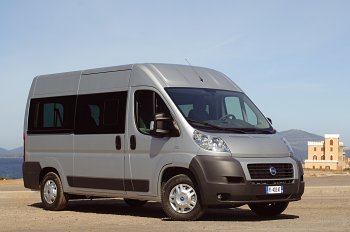
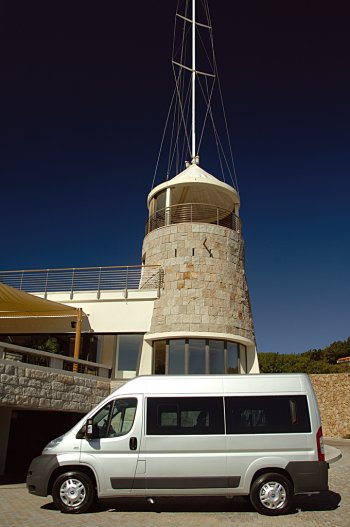 |
|
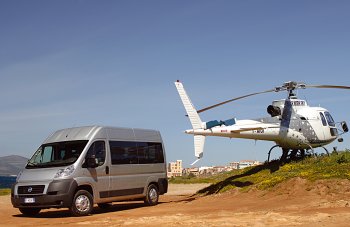
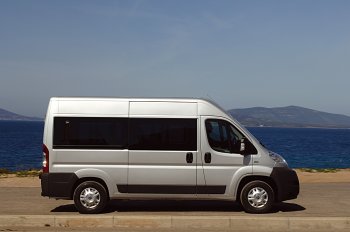
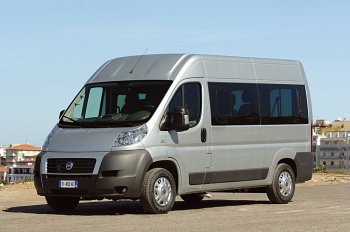 |
|
• new wheel struts to achieve an optimum suspension
geometry;
• new design offset coil springs to increase the absorption
of minor road roughness;
• triangular finned lower arm with bullhead fixed to the
wheel sub-axle and anchored by flexible bushes to the
chassis mechanical beam;
• mechanical beam designed to achieve the new gross vehicle
weight target of 4 tonnes and secured to the body as a
support for all front suspension parts (arms, steering box
and anti-roll bar);
• telescopic shock absorbers secured to the body by means of
flexible blocks and dust protections fitted to the shock
absorbing blocks.
Rear suspension
The New Ducato rear suspension is similar in layout and
architecture to the rear suspension of the previous model
that displays certain major new features. Beginning with a
reduction in height of the load platform and an increase in
the rear track from 1740 to 1790 mm compared to the previous
model.
And including versions with:
• 4000 kg gross vehicle weight;
• oversized track (up to 1980 mm for bases used by leisure
vehicle bodybuilders);
• self-levelling air suspension which may be fitted to all
specifications, payload and wheelbases.
The New Ducato adopts a rigid rear axle layout with leaf
springs that feature shock absorbers located beneath the
floor line. This means that the suspension does not intrude
on the vehicle and offers greater width between wheelarches,
thus resulting in a linear load compartment that can be used
more effectively. The new square section tubular axle
reduces bending when laden and achieves the objective of an
overall gross vehicle weight of up to 4 tonnes and a maximum
permissible load of 2400 kg. The shock absorbing blocks
secured to the rail have been improved to withstand the
force and consequent stress generated by the increased load
target more effectively. The leaf spring mounting brackets
have also been removed and the fastening systems have been
optimised (the leaf springs are secured directly to the
body), thus also reducing the weight.
So much for the new technical features. In terms of the
settings adopted for flexible and damping components, the
range of rear suspension systems offered by the New Ducato
is very broad to meet all transport, attitude and comfort
requirements. For example, Panorama versions are fitted with
variable rate Comfort type leaf springs with sliding bushes
to ensure outstanding driving conditions. Maxi versions may
be fitted with three types of leaf spring (1 single and 2
double) according to the type of operating mission. In
particular, the double leaf springs of the new van offer
reduced flexibility and are particularly suitable for heavy
duty use or heavy conversions on chassis cab and chassis
cowl bases, while the single leaf springs are better suited
for vans.
One rear suspension is available with track oversized to
1980 mm (the normal track is 1790 mm). This is mainly
combined with leisure conversion bases (camper, box
vehicles, mobile shops and special conversions). Due to
their high centre of gravity, these applications are also
fitted with a special antiroll bar as standard.
Self-levelling rear air
suspension
The self-levelling air suspension deserves separate mention.
This innovative feature guarantees great comfort and ensures
constant attitude under all load conditions (vehicle full or
empty, goods provision symmetrically or asymmetrically) and
allows the rear load threshold to be reduced (up to -70 mm)
to facilitate goods loading/unloading operations or to raise
the vehicle at the rear to improve the ramp angle and/or
passing over an obstacle beneath the vehicle. Compared to
normal suspension systems, the load threshold level is lower
and allows the user to lower it still further by means of
buttons on the dashboard. For safety reasons, the attitude
may be adjusted only with the vehicle at a standstill while
the buttons are active even with the engine off. In detail,
11 positions may be selected (5 lifting, 5 lowering in
addition to position 0, which corresponds to the driving
level). Once adjusted, the attitude remains set to a speed
of 15 km/h. Once this speed has been exceeded, the attitude
is automatically restored to the nominal driving height.
Innovative equipment
Parking sensors
The New Ducato may also be equipped with a parking sensor, a
device that comes on automatically when reverse is engaged
(a special button turns it off). This helps with manoeuvring
in tight spots or when visibility is particularly bad by
notifying the driver of obstacles behind the vehicle that
are outside his field of vision. Four ultrasonic sensors
built into the rear bumper monitor the area behind the
vehicle and send the information received to a
microprocessor control unit that combines the data and
detects the presence of potential obstacles. The system
notifies the driver by means of an intermittent acoustic
signal. Sound emission frequency is inversely proportional
to distance to the obstacle (the signal is continuous below
250 mm). The New Ducato is also fitted with an external
acoustic indicator to warn people in the vicinity of the
vehicle when it is manoeuvring.
Rain/dusk sensor
Excellent visibility at all times is an important passive
safety factor. The New Ducato may be fitted as an option
with a rain and dusk sensor. This system fitted in the upper
part of the windscreen behind the interior rear view mirror,
first detects the presence of rain and then manages the
windscreen wiper according to the amount of water present on
the glass. When in dusk sensor mode, the device checks
external brightness and automatically turns on the headlamps
(side lights and low beams)
Reflective windscreen
This is made out of laminated glass that reflects a
significant proportion of solar energy due to fine metal
oxide layers deposited between the two sheets of glass.
Compared to a standard windscreen, the amount of heat from
the sun entering the passenger compartment is drastically
reduced for an enormous improvement in thermal comfort. The
uncomfortable burning sensation of sunlight on the
occupants, the dashboard and the steering wheel can be
reduced (thus allowing less wear on interior plastic and
leather components and on the seals). Passenger comfort is
increased and air conditioner use can be limited for
improved on-board well-being and lower fuel consumption. The
reflective windscreen is particularly effective when the
vehicle is parked in the sun: it reduces the air inside the
passenger compartment by up to 15°C.
Fix&go Kit
The automatic Fix&go fast tyre repair kit consists of a
canister of sealant fluid, a small compressor with pressure
gauge and various adaptors for inflation. The kit allows you
to restore tyre pressure in the event of a puncture and
continue on your journey, though you will eventually need to
have the tyre repaired by a professional. The compressor may
also be used only to check and top up the pressure. This kit
means you do not have to carry a spare wheel and it is very
useful when you want to minimise weight/bulk in the vehicle.
Variable power steering
The technical features of the New Ducato steering system are
responsible for its safe, precise steering at motorway
speeds, its great handling at all speeds and the limited
force required on the steering wheel during parking
manoeuvres and when driving around town at low speed. A
state-of-the-art variable power steering system is available
as standard on the 160 Multijet and as an option on the 120
and 130 Multijet. This constitutes a real first for the
Light Commercial Vehicle segment. A system that makes light
work of any manoeuvre, even during parking, by slashing the
effort required at the wheel by almost half compared to a
normal power steering system (from 5.5 Nm to 3.5 Nm in
manoeuvres from a standing start with the vehicle fully
laden.) It also guarantees maximum steering precision at
high speeds, modulating the driver’s effort in a gradual
manner.
Cruise control
The New Ducato’s list of new options includes an electronic
speed governor (Cruise Control). This device allows you to
drive to your chosen destination without having to press the
accelerator. This makes for extra comfort, particularly on
long motorway trips. The Cruise Control may only be
activated above 30 km/h. The operation is carried out by
means of the wheel on the left dedicated column switch. The
‘+’ and ‘-’ controls may be used to adjust the set speed.
The device turns itself off automatically when you press the
brake or clutch pedals or it may be controlled by a button.
To return to automatic mode, simply press the ‘resume’ key
on the head of the same lever.
TV camera system and rear
visibility display
The system allows the driver to see what is happening behind
the New Ducato. It consists of a TV camera located on the
van’s rear roof beam (which incorporates the third brake
light) and a display on the cab oddment shelf beneath the
ceiling. The system is activated with the key inserted at a
speed below 15 km/h by engaging reverse or by means of a
button. It is deactivated when a speed of 18 km/h is
exceeded. When reverse is deactivated, the image remains on
the display for a further 5 seconds. Visibility is
guaranteed at night and irrespective of the weather or
vehicle conditions (even when fully laden). The TV camera
guarantees a minimum coverage of 3.5 metres in length and 6
metres in maximum width.
The Blue&Me system
The New Ducato may be fitted with ‘Blue&Me’, an innovative
Windows Mobile based device arising out of a joint venture
between Fiat Auto and Microsoft. This changes the paradigms
of in-car communication, information and entertainment to
improve the comfort and quality of time spent aboard the
vehicle. The easy-to-use device allows you to make/receive
phone calls and listen to music while driving in a simple,
safe manner. Bluetooth ® technology allows you to
communicate with the outside world from the vehicle via your
own personal devices such as mobile phones or hand-held
computers. The product will subsequently be complemented by
more advanced devices that allow you access to the numerous
new products that technological progress has in store for us
over the coming years: from full multimedia capability to
satellite navigation. Not to mention the availability of a
set of services designed to make your journeys more
convenient, safe and easy.
The ‘Blue&Me’ offers a sophisticated handsfree system with
voice recognition that allows customers with Bluetooth ®
mobile phones to use their phones even when in their jacket
pockets or handbags. This system automatically lowers the
radio volume (if turned on) and allows you to hear the
person you are speaking to through the stereo speakers. The
system also features a high level of compatibility with
mobile phones currently on the market and may be updated to
new standards and to future telephones.
In detail, the ‘Blue&Me’ is fully integrated in the vehicle.
The control keys are located on a panel in the centre of the
dashboard to allow immediate and safe access to the system.
It is also possible to find a number in your phone book by
scrolling through the control panel display or mute the
device for a private conversation. Among the main features,
note that you store your own mobile phone on the system once
only. And more: the personal phone book may be transferred
fully and then updated automatically whenever the system
detects the mobile phone. No voice learning stage is
required due to the state-of-the-art voice recognition
system. The device is also able to store up to 5 mobile
phones, thus permitting more than one user in the same
vehicle to make immediate use of the handsfree set; the
programming may naturally be changed as and when required.
So much for the handsfree system with voice recognition; the
innovative Blue&Me system offers something else: it allows
you to listen to your favourite music recorded on your
mobile, on the new smart phones, on an MP3 player or on a
USB flash drive. This is achieved by means of a USB port in
the glove compartment that allows you to connect any digital
device with an analogue connection. In this way, you can
play music audio files (MP3, WMA and WAV) directly through
the stereo. |
|